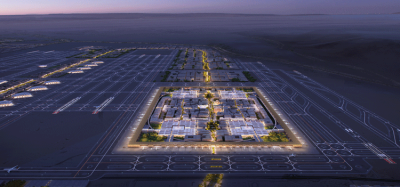Houston’s approach to accommodating the Airbus A380
- Like
- Digg
- Del
- Tumblr
- VKontakte
- Buffer
- Love This
- Odnoklassniki
- Meneame
- Blogger
- Amazon
- Yahoo Mail
- Gmail
- AOL
- Newsvine
- HackerNews
- Evernote
- MySpace
- Mail.ru
- Viadeo
- Line
- Comments
- Yummly
- SMS
- Viber
- Telegram
- Subscribe
- Skype
- Facebook Messenger
- Kakao
- LiveJournal
- Yammer
- Edgar
- Fintel
- Mix
- Instapaper
- Copy Link
Posted: 27 May 2015 | Jeffrey K.A. Brown, Houston Airport System
With the arrival of the first two Airbus A380 arriving at Houston’s George Bush Intercontinental Airport (IAH), Chief Development Officer Jeffrey K.A. Brown explains the airports approach to accommodating the aircraft through infrastructure and ground handling operations.
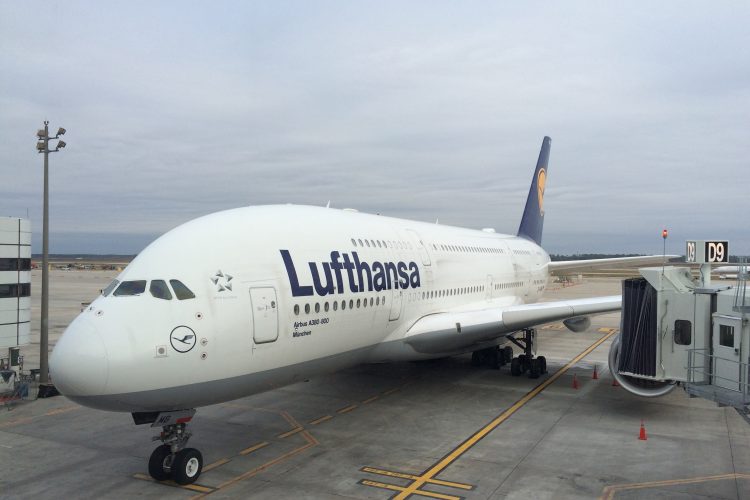

Chances are you’ve heard the phrase “everything’s bigger in Texas.” That simple and direct expression happens to be a tremendous source of pride for Texans, as it encapsulates a very distinct spirit that permeates throughout the Lone Star State and encourages its residents to “think and dream big”. It also happens to be an accurate description of the aviation trend currently unfolding at George Bush Intercontinental Airport (IAH) in Houston, Texas. With 41 million passengers passing through its gates on an annual basis, IAH is already a major player on the global aviation route map but within the past few years, its presence within the industry has literally been growing, with the arrival of two Airbus A380 aircraft.


Jeffrey K.A. Brown, Chief Development Officer of Planning, Design and Construction Division, Houston Airport System
The excitement began in August 2012, when Lufthansa Airlines made Houston the first city in Texas to host regular scheduled air service featuring the A380 aircraft, upgauging its nonstop flight to Frankfurt, Germany. Hundreds of Houstonians came out to an airport viewing party, simply hoping to catch a glimpse of the aircraft as it touched down on the IAH runway. Two years later and Emirates made a similar splash on the Houston aviation scene, utilizing the A380 aircraft for its route to Dubai, in the United Arab Emirates.
The arrival of these aircraft is a testament to the strength of Houston’s economy and the diversity of its population. The nation’s fourth-largest city stands as an undisputed leader in the area of job creation, with well-established success in key business sectors such as energy, manufacturing and various medical-related fields. In large part because of this economic success, Houston has also consistently stood as a national leader in the area of population growth, projected by the United States Census Bureau to lead America in this category through the year 2040. One of the most exciting results of this unprecedented growth trend is the fact that Houston now ranks as the most diverse population of any major city found anywhere in the United States. This influx of international flavor has led to two exciting developments, a unique and dynamic cultural experience and a flood of new international air carriers establishing flight operations at George Bush Intercontinental Airport. In fact, between April 2013 and April 2015, 11 international airlines either launched or announced new operations in Houston, Texas.
In many respects, the Airbus A380 aircraft is the perfect personification of this oversized success. Currently the world’s largest commercial aircraft, the A380 has a seat capacity of 544 passengers in a comfortable four-class configuration. But like economic success and population growth, the A380 aircraft also brings with it the need for planning and coordination. Team members with the Houston Airport System (HAS) now have a full appreciation for this fact, having gone through the accommodation process on two separate occasions.
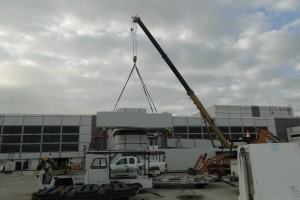

Construction of Gate D9 at George Bush Intercontinental Airport
It’s a process that begins with the melding of imagination and models, spending countless hours considering and contemplating various arrangements of various aircraft at IAH. Different gate configurations were evaluated using a host of aircraft, such as the Boeing 787 Dreamliner, Boeing 777 and Boeing 747. The evaluation process quickly led us to several significant hurdles. First, because the aircraft would be parked so close to the international terminal building, there was a tremendous amount of difficulty in finding ample space for the various ground support equipment necessary for the operation of such an aircraft. The second challenge involved the fact that the A380 aircraft requires fueling from both sides and prior to our modifications, the fuel pits at IAH were not found in the required location. And finally, the existing ground power units (GPUs) and pre-conditioned air units (PCA) were not capable of handling the demands of an A380 aircraft.
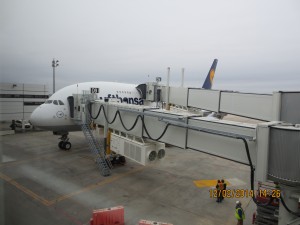

Upper level boarding had to be provided to load and unload the A380 in a timely manner and to provide an adequate level of service to premium passengers. The terminal building had to be structurally modified, as elevated exterior walkways up to 200’ in length had to be constructed to connect to the new loading bridges. The building electrical system also had to be upgraded to accommodate the increased power demands of the A380 and the PCA units were converted from glycol to electric. Additionally, parking the A380 required taking adjacent gates out of service. To accommodate the dislocated aircraft, other narrowbody gates had to be upgraded for widebody operations.
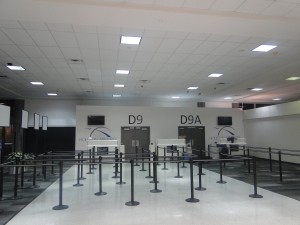

The matter of time and pending deadlines was also a constant cause for concern during the preparation phase for both Lufthansa Airlines as well as Emirates. Both airlines were understandably anxious to launch the A380 aircraft at IAH and both required a firm deadline as to when the required work would be completed and the inaugural flight could take place. Once again, communication and coordination were absolutely essential in making sure that the most efficient work schedule was followed. HAS team members began an early dialogue with representatives from Allied Fuel in order to make absolutely sure that the new fuel pits were set to be located in the correct location. Similar conversations were initiated with the manufacturer of the necessary loading bridges. Since the Infrastructure staff at George Bush Intercontinental Airport had never installed a dual jet bridge at IAH before, the entire process was new to those involved and the HAS team relied heavily on the expertise offered from those providing the materials. This allowed the work to be completed in an efficient amount of time. In both instances (the Lufthansa Airlines launch and the Emirates launch), the Houston Airport System was facing a deadline that granted them only a few months in which to complete the required tasks. In both instances, the work was completed within the necessary timeframe and the inaugural flights went off without any significant difficulty.
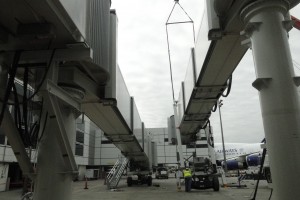

The mission of the Houston Airport System is to “connect the people, businesses, cultures and economies of the world to Houston.” This is a challenge that’s taken very seriously within the ranks of the HAS team and I am proud to say, it’s a challenge that’s been met with unprecedented success in recent years. George Bush Intercontinental Airport is currently enjoying record-breaking numbers in the area of international travel and William P. Hobby Airport (HOU) has set all-time records for passenger traffic in each of the last four years. Houston’s global route map offers nonstop air service to almost 200 different destinations found in the U.S. and around the world, and this historic growth is being accommodated through major construction projects that are either already underway or deep within the planning phase. And the emergence of the A380 aircraft is definitely part of the conversation when HAS leaders discuss future growth plans. The airport system is currently moving forward with the construction of a new international terminal building at IAH, a facility that will feature 15 widebody-capable gates. Four of those gates will be specifically designed to accommodate the Airbus A380 aircraft.
The world may be getting smaller but everything is still bigger in Texas. And within the Houston Airport System team, there is a belief that those two realities can coexist in perfect harmony, provided the necessary coordination and planning is allowed to take flight.
Biography
Jeffrey K.A. Brown is the Chief Development Officer of the Planning, Design and Construction Division for the Houston Airport System. Brown is responsible for overseeing the administration of design and construction contracts, managing long-term and short-term airport projects, analyzing operations and implementing best practice policies and procedures at the Houston Airport System.
Prior to joining HAS, Brown served as an Engineering Design Manager for the 451st Air Expeditionary Wing (USAF) in Kandahar, Afghanistan and was the Director of Engineering for KBR in Anbar province, Iraq.
Brown has more than 20 years of experience in aviation planning, design and construction/project management in both the civilian and military sectors. His extensive experience in the aviation industry was obtained from working at large airports such as New York’s JFK International and LaGuardia airports, Hartsfield-Jackson Atlanta International Airport, McCarran Airport and smaller regional and general aviation airports in the Maryland and Virginia.
Brown has a Bachelor’s degree in civil engineering from the University of the West Indies, a Master’s degree from Columbia University (New York), an MBA from the City University of New York (Baruch College). Additionally, Brown is a licensed professional engineer in New York and Georgia, a Certified Member (CM) of the American Association of Airport Executives and a Project Management Professional (PMP) with the Project Management Institute.





